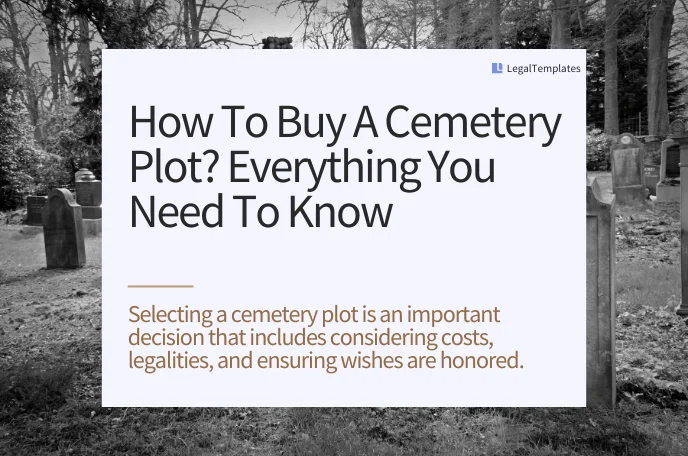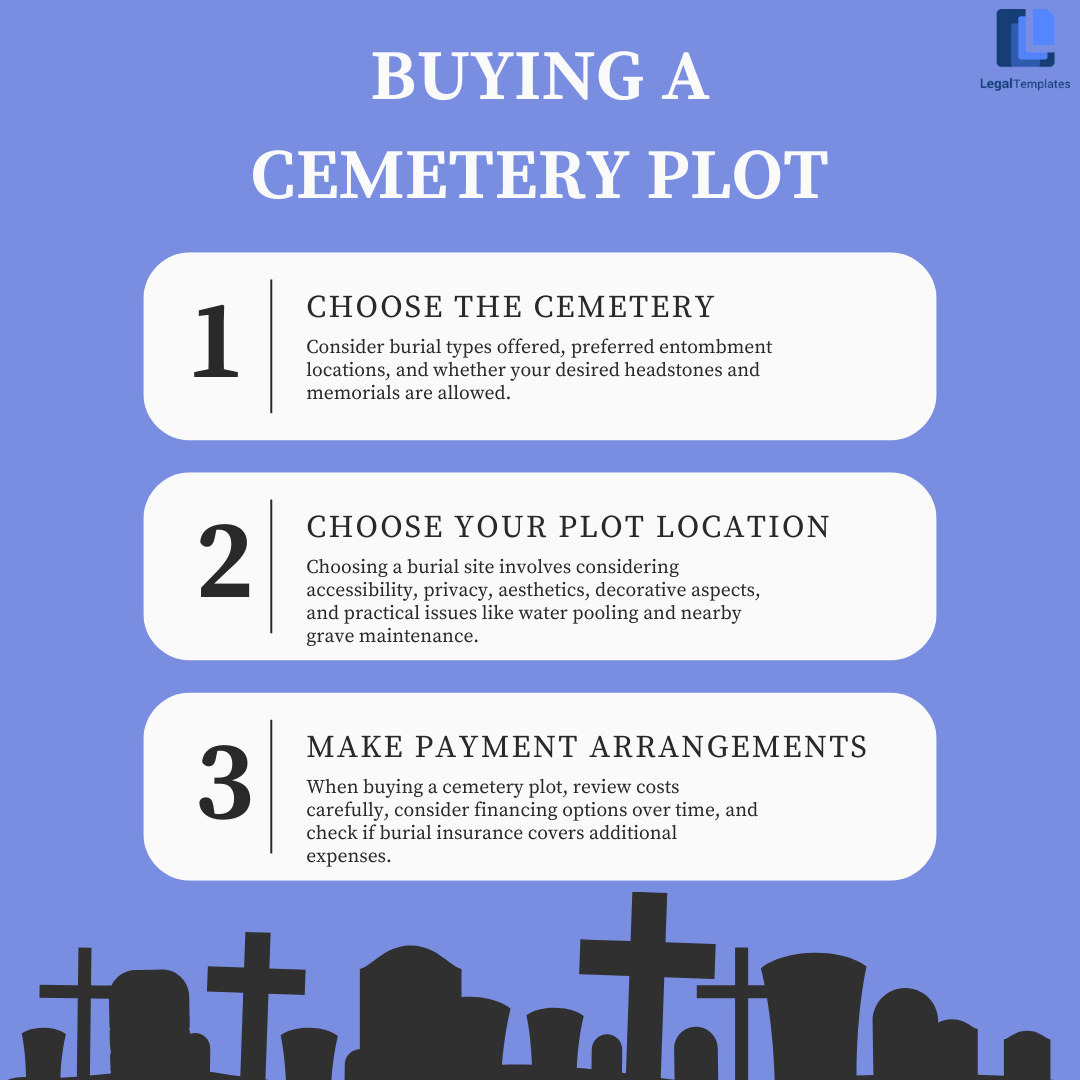
Selecting a cemetery plot is a significant emotional and legal decision. Making burial and funeral arrangements can be an uncomfortable process, as you must consider your mortality. The legal considerations can be equally challenging, as you must be able to ensure your end-of-life wishes are clearly documented and honored after your passing.
Establishing a burial plot in advance lets you enjoy peace of mind, knowing your wishes will be fulfilled. Understanding how to buy a cemetery plot, including the site, costs, and legal considerations, can help you make the best decision for you and your loved ones. You can further simplify the process by completing your end-of-life plan, will, power of attorney, and other estate planning forms through an established legal template.
Three-Step Process of Purchasing a Cemetery Plot

Many people opt to purchase a cemetery plot in advance. Buying a burial plot in advance gives you more control over the process. You can often buy a plot and associated items at a lower cost, especially if there is limited space in your desired cemetery. You also have a better chance of obtaining a desirable location in your cemetery of choice. Finally, you can ensure the plot selection and purchase are taken care of before you pass, so your loved ones do not have to manage payment in full while grieving your passing.
But how do you buy a cemetery plot? The process for pre-purchasing a cemetery plot can differ depending on the cemetery. The following steps can help you understand how to find a burial plot and address potential issues before they arise.
Step 1: Choose the Cemetery
Selecting the right cemetery involves numerous considerations. Consider the following factors when choosing a cemetery for your burial plot:
- Burial type: Consider whether the cemetery offers the type of burial you want, such as a cremation urn, casket, ash scattering, or natural burial.
- Entombment location: Determine whether the cemetery offers the above- or below-ground or other burial location you prefer.
- Headstones and memorials: Determine whether the cemetery will allow the headstone or other memorial you want on your grave site.
Step 2: Choose Your Plot Location
When you have selected the cemetery, consider where you want your burial site within the cemetery grounds. Factors that could affect your burial plot selection include:
- Accessibility from the road or driveway
- Privacy for mourners and visitors
- Aesthetic appearance and landscaping
- Decorative features and memorials
- Practical considerations, such as pooling water and care of nearby grave sites
Step 3: Make Payment Arrangements
Once you select the burial sites you want, you can contact the cemetery owner to seek pricing information and payment options. Some cemeteries charge extra for memorial care and labor costs in addition to the actual costs for the burial plot. Review your contract carefully and ensure the costs are clearly outlined.
When you purchase a cemetery plot in advance, you can often pay for it over time with dedicated financing. This is yet another advantage to buying your cemetery plot in advance. You can also take the opportunity to determine whether your burial insurance covers caretaking expenses and other costs.
Types of Cemetery Plots
Selecting a cemetery plot is a profoundly personal decision based on how you wish to be interred and whether you want to be buried with others. When selecting how you wish to be buried, you typically have two options: in-ground and above-ground.
In-Ground Cemetery Plot Options
You may choose to have your urn, casket, or other receptacle of your remains buried in the ground. A headstone or other memorial typically marks in-ground burial plots. Types of in-ground burials include:
- Single-depth: Used for a single person’s burial
- Double-depth: Used for two people stacked atop one another
- Family lot: Used for people in a specific family
- Lawn crypt: Used to bury multiple individuals in a pre-constructed vault
- Private estate: Used when people create a separate burial area divided from the rest of the cemetery
Above-Ground Cemetery Plot Options
An above-ground plot does not involve a grave or burial. Instead, urns, caskets, and other receptacles are housed in a structure. Examples of above-ground plots include:
- Private mausoleums, which typically house the caskets or urns of individuals, couples, or families
- Public mausoleums, also called community mausoleums, which house anyone who wants to purchase space in the mausoleum
- Columbaria, or columbarium niches, which are individual compartments in a wall, mausoleum, or other structure used to house cremation urns
Types of Cemeteries
There are many cemeteries to choose from, depending on your personal and religious preferences. For instance, if you are a church member, you may choose to be buried in your church’s cemetery. On the other hand, you may wish to return to nature through a natural burial, which may require specialized treatment and interment in a specifically licensed cemetery.
Typical cemetery types include:
- Church cemeteries, or graveyards, are cemeteries located on church property, typically reserved for members of the church’s congregation.
- Religious cemeteries are allocated for worshippers of a specific religion but are not necessarily located on the site of a religious building like a church.
- Garden cemeteries use monuments, tombstones, statues, and landscaping features to create a garden-like atmosphere.
- Municipal cemeteries are typically managed by a city or municipality, and burial permissions may vary by location.
- Memorial parks include flat markers rather than headstones, statues, and other upright markers common in traditional cemeteries.
- Veteran cemeteries are official burial sites for veterans and their families, owned and managed by the Veteran Affairs Administration (VA).
- Green cemeteries, or natural cemeteries, allow deceased persons to be buried in nature, rather than entombed or cremated in a traditional manner.
Duration and Ownership of Cemetery Plots
Cemetery plot ownership is typically forever. However, some states and localities have laws and regulations that allow for the repossession of a burial plot.
For example, Florida statutes allow the cemetery to repossess a plot if the owner fails to update their residential address with the cemetery and cannot be reached for 50 consecutive years [1] . In certain circumstances, other states may allow for exhumation, excavation, or removal of remains.
Before purchasing your cemetery plot, check with your state and local laws to understand how your plot will be managed following your death. For instance, if you wish to be buried in a family plot on your property, determine whether your state or local laws will permit the cemetery to be moved or modified if another owner purchases the property.
Understanding Costs
Understanding how to purchase a cemetery plot can ensure your loved ones, extended family, and next of kin have a dignified location to gather and honor your memory without worrying about the financial ramifications.
On average, a single cemetery plot can cost anywhere from $1,000 to $5,000. The cost varies widely depending on the type and location of the cemetery and the location of your plot. With additional expenses like grave liners, urns, and headstones, plot costs can exceed $10,000.
| Type of Cemetery Plot | Average Cost |
|---|---|
| Single Plot | $1,000 - $5,000 |
| Companion Plot (Double Plot) | $3,000+ |
| Family Plot | $20,000+ |
| Cremation Plot | $350 - $3,000 |
| Green Burial Plot | $500 - $5,000 |
| Pre-Owned Burial Plot | Varies (Negotiable) |
Public vs. Private Cemeteries
When selecting a burial plot, you can be interred in a public or private cemetery. A public cemetery is a cemetery for a community, such as a city, town, neighborhood, or church. Public cemeteries are open to public use. Private cemeteries, on the other hand, limit plot sales to family members by blood or marriage, or other groups as defined by state and local statutes.
A public cemetery burial plot is typically less expensive than a private one. While public plots can average between $200 and $2,000 for a single plot, private plots often range between $2,000 and $5,000.
Additional Considerations
When considering your final resting place, you should also discuss the following items with the cemetery and your loved ones:
- Headstone and memorial structures: Understand the cemetery’s requirements and regulations for headstones, memorials, statues, and other markers. They may have specific requirements for headstone materials, sizes, shapes, contents, and more.
- Grave decorations: Every cemetery has different rules regarding grave decorations. For instance, your loved ones may be allowed to leave flowers, but not in a breakable glass vase. Items that may be prohibited in a cemetery include large flags, banners, bird feeders, wind chimes, candles, glass items, fencing, or stakes.
- Family and loved ones: Consider how close your cemetery plot is to loved ones who may wish to visit the site. In addition, consider whether there is room for your loved ones or family members who may wish to be buried nearby.
Average Funeral Cost
The median cost of a funeral with viewing and burial in 2023 was $8,300, according to the National Funeral Directors Association.
Incorporating Cemetery Plot Decisions Into Legal Plans
Your choice of cemetery plot is a crucial part of your end-of-life plan. You may wish to locate and purchase your cemetery plot in advance to avoid legal complications following your death. By including the plot in your end-of-life plan rather than your final will and testament, you ensure you will be laid to rest where you want.
In addition, you avoid passing on financial and legal issues to your heirs and descendants. Your plot is already located and paid for, and you have arranged payment through your own estate or insurance policy.
Including your cemetery plot in your end-of-life plan also means your family and loved ones need not wait for probate or other legal proceedings before they can arrange the funeral and burial. Additionally, you can avoid confusion that may arise between the estate’s beneficiaries.
Estate Planning Templates and Forms
Using the proper estate planning documents can help you prevent unnecessary confusion following your death. Estate planning documents you might find helpful include:
